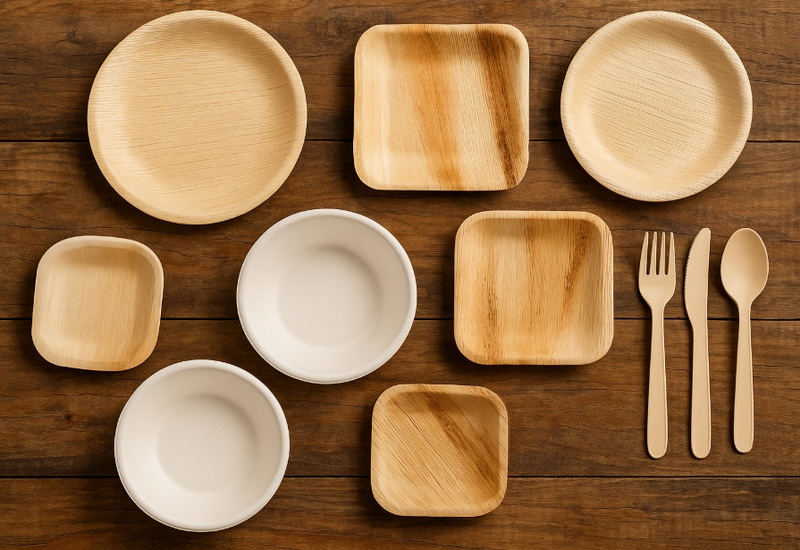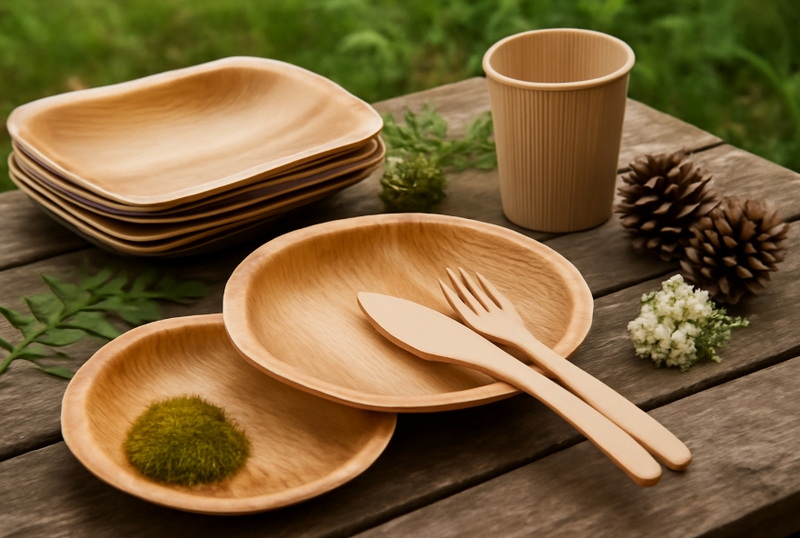
Content Menu
● The Rise of Disposable Plate Manufacturers and Suppliers in Japan
>> Key Drivers of Growth
● Key Types of Japanese Disposable Plates
>> Washi Paper Plates
>> Bamboo Plates
>> Wooden Plates
>> Bagasse Plates
>> Fukusa Plates
● Leading Disposable Plate Manufacturers and Suppliers in Japan
>> WASARA: The Pinnacle of Japanese Disposable Tableware
>>> Key Features of WASARA Plates
>> Other Notable Japanese Suppliers
>>> Local Artisans and SMEs
>>> OEM Specialists
>> Comparison of Japanese Disposable Plate Types
● The Role of OEM Services in the Disposable Plate Industry
>> Benefits of OEM Partnerships
>> How to Partner with Japanese OEM Suppliers
● Trends and Innovations in Japanese Disposable Tableware
>> Tree-Free and Renewable Materials
>> Compostable and Biodegradable Products
>> Minimalist and Elegant Designs
>> Enhanced Functionality
>> Corporate Social Responsibility
● Export and International Market Reach
>> Why International Buyers Choose Japanese Suppliers
>> Tips for Importing Japanese Disposable Plates
● Applications of Japanese Disposable Plates
>> Catering and Events
>> Restaurants and Cafés
>> Outdoor and Recreational Use
>> Traditional and Cultural Events
>> Home Use
● Challenges and Opportunities
>> Challenges
>> Opportunities
● Conclusion
● Frequently Asked Questions
>> 1. What makes Japanese disposable plates unique compared to other countries' products?
>> 2. Are Japanese disposable plates suitable for hot and cold foods?
>> 3. Can I order customized disposable plates from Japanese suppliers for my brand?
>> 4. How eco-friendly are Japanese disposable plates?
>> 5. What are the main applications for Japanese disposable plates?
In today's fast-paced world, the demand for disposable tableware is at an all-time high. As global awareness of environmental issues grows, the search for sustainable, high-quality, and aesthetically pleasing disposable plates has led many businesses and consumers to Japan. Renowned for innovation, meticulous craftsmanship, and a deep-rooted respect for nature, Japanese manufacturers have become leaders in the disposable plate industry. This comprehensive guide explores the top disposable plate manufacturers and suppliers in Japan, their unique offerings, the role of OEM services, and the trends shaping the future of disposable tableware.

The Rise of Disposable Plate Manufacturers and Suppliers in Japan
Japan's disposable plate industry has evolved significantly over the past decade. While convenience has always been a driving factor, recent years have seen a pronounced shift towards sustainability, quality, and design. Japanese manufacturers have responded by developing products that not only meet practical needs but also align with global environmental standards.
Key Drivers of Growth
- Environmental Awareness: Japanese consumers and businesses are increasingly eco-conscious, demanding products that minimize environmental impact. This has spurred manufacturers to adopt biodegradable, compostable, and tree-free materials.
- Cultural Aesthetics: Japanese design principles, such as minimalism, harmony, and respect for nature, are evident in disposable plate designs. These aesthetics appeal to both domestic and international markets seeking elegance and sophistication.
- Global Demand: Japanese disposable plates are exported worldwide. Their reputation for quality, safety, and sustainability makes them a preferred choice for international brands, wholesalers, and event organizers.
Key Types of Japanese Disposable Plates
The diversity of disposable plate options in Japan reflects the country's commitment to both tradition and innovation. Here are the main types available:
Washi Paper Plates
Washi paper, a traditional Japanese material, is renowned for its strength, flexibility, and beauty. Washi paper plates are lightweight, biodegradable, and suitable for both formal and casual occasions. They are often used in tea ceremonies and high-end catering, where presentation is as important as functionality.
Bamboo Plates
Bamboo is a fast-growing, renewable resource, making it an ideal material for sustainable disposable plates. Japanese bamboo plates are sturdy, lightweight, and compostable. They are commonly used for outdoor events, picnics, and eco-friendly catering.
Wooden Plates
Known as 'kiri' plates, these are crafted from thin sheets of Japanese paulownia wood. Wooden plates are popular for sushi, sashimi, and traditional Japanese meals. They offer a natural look and feel, and many are reusable or compostable.
Bagasse Plates
Bagasse is a byproduct of sugarcane processing. Increasingly used by Japanese manufacturers, bagasse plates are strong, heat-resistant, and fully biodegradable. They are suitable for both hot and cold foods and are gaining popularity in the food service industry.
Fukusa Plates
Fukusa plates are unique to Japanese culture. These are cloth-wrapped disposable plates used in ceremonial settings, symbolizing respect, cleanliness, and attention to detail.
Leading Disposable Plate Manufacturers and Suppliers in Japan
Japan is home to several outstanding disposable plate manufacturers and suppliers, each with its own strengths and specialties.
WASARA: The Pinnacle of Japanese Disposable Tableware
WASARA is perhaps the most internationally recognized Japanese disposable plate manufacturer. Established in Tokyo in 2008, WASARA has set a new standard for disposable tableware by combining traditional Japanese aesthetics with cutting-edge eco-friendly materials.
Key Features of WASARA Plates
- Materials: WASARA uses tree-free materials such as bamboo, reed pulp, and bagasse. All products are fully biodegradable and compostable.
- Design: WASARA plates are inspired by Japanese art, featuring minimalist lines and elegant shapes. They resemble porcelain but are entirely disposable.
- Functionality: These plates are oil- and water-resistant, microwave-safe, and sturdy enough for a wide range of foods.
- Environmental Impact: WASARA products decompose within 90 days and leave no toxic residue. The company is committed to sustainability and social responsibility.
- Recognition: WASARA has received numerous awards, including the Good Design Award and the Asian Award.
Other Notable Japanese Suppliers
While WASARA is a flagship brand, many other Japanese manufacturers and suppliers contribute to the industry's diversity and excellence.
Local Artisans and SMEs
Small and medium-sized enterprises (SMEs) play a vital role in the Japanese disposable plate market. These companies often specialize in traditional materials like washi paper and bamboo, producing plates for both domestic use and export. Their products are valued for their authenticity, craftsmanship, and customization options.
OEM Specialists
Several Japanese factories focus on OEM (Original Equipment Manufacturer) services. They offer custom design, branding, and packaging for foreign brands, wholesalers, and producers. These suppliers can accommodate a wide range of order sizes and specifications, making them ideal partners for international businesses seeking to launch their own line of disposable plates.
Comparison of Japanese Disposable Plate Types
| Plate Type | Material | Eco-Friendly | Typical Use Cases | Notable Features |
| WASARA | Bamboo, Bagasse | Yes | Events, catering, home, export | Award-winning design, sturdy |
| Washi Paper Plate | Washi Paper | Yes | Tea ceremonies, parties | Lightweight, flexible |
| Bamboo Plate | Bamboo | Yes | Outdoor events, picnics | Strong, compostable |
| Wooden Plate | Kiri Wood | Yes | Sushi, sashimi, traditional meals | Natural look, reusable |
| Bagasse Plate | Bagasse | Yes | Food service, takeout, catering | Heat resistant, sturdy |
The Role of OEM Services in the Disposable Plate Industry
OEM services are a cornerstone of the Japanese disposable plate industry. They enable foreign brands and wholesalers to source high-quality, customized products that meet the unique needs of their markets.
Benefits of OEM Partnerships
- Customization: Japanese manufacturers can produce plates in various shapes, sizes, materials, and designs to match client specifications.
- Branding: OEM services include custom logos, packaging, and labeling, allowing international brands to differentiate themselves in competitive markets.
- Flexible Order Quantities: Japanese suppliers cater to both small and large orders, making them accessible to startups and established businesses alike.
- Quality Assurance: Strict quality control processes ensure that every plate meets high standards of safety, durability, and appearance.
How to Partner with Japanese OEM Suppliers
1. Identify Potential Suppliers: Research manufacturers with experience in your preferred materials and product types.
2. Request Samples: Evaluate product quality, design, and functionality by requesting samples.
3. Negotiate Terms: Discuss pricing, minimum order quantities, lead times, and customization options.
4. Place Orders: Once terms are agreed upon, place your order and monitor production progress.
5. Quality Inspection: Many suppliers offer third-party quality inspections to ensure products meet your specifications before shipping.

Trends and Innovations in Japanese Disposable Tableware
Japanese disposable plate manufacturers and suppliers are at the forefront of industry trends and innovations. Here are some of the most significant developments:
Tree-Free and Renewable Materials
The shift towards tree-free materials, such as bamboo and bagasse, reflects a commitment to reducing deforestation and promoting sustainability. These materials are renewable, biodegradable, and have a lower environmental footprint than traditional paper or plastic.
Compostable and Biodegradable Products
Japanese manufacturers prioritize products that break down quickly and safely in composting environments. Certifications and eco-labels are commonly used to assure customers of a product's environmental credentials.
Minimalist and Elegant Designs
Aesthetic appeal is a hallmark of Japanese disposable plates. Manufacturers invest in design, ensuring that even disposable tableware can elevate the dining experience. Minimalist lines, natural textures, and harmonious shapes are common features.
Enhanced Functionality
Modern Japanese disposable plates are designed for versatility. They are often microwave- and fridge-safe, oil- and water-resistant, and sturdy enough for a variety of foods. This makes them suitable for both home use and professional catering.
Corporate Social Responsibility
Many Japanese companies integrate social responsibility into their business models. For example, some donate a portion of sales to environmental causes or participate in community clean-up initiatives. This commitment enhances brand reputation and appeals to socially conscious consumers.
Export and International Market Reach
Japanese disposable plate manufacturers and suppliers have a strong presence in international markets. Their products are exported to North America, Europe, Southeast Asia, and beyond.
Why International Buyers Choose Japanese Suppliers
- Unmatched Quality: Japanese manufacturers are known for their attention to detail and high production standards.
- Innovation: Continuous investment in research and development leads to innovative materials and designs.
- Reliability: Japanese suppliers are dependable partners, delivering products on time and as promised.
- Sustainability: Eco-friendly materials and processes align with global trends and regulatory requirements.
Tips for Importing Japanese Disposable Plates
- Understand Import Regulations: Ensure that products comply with your country's safety and environmental standards.
- Communicate Clearly: Language barriers can be overcome by working with suppliers experienced in international trade.
- Plan for Lead Times: Allow sufficient time for production, quality inspection, and shipping.
- Build Relationships: Long-term partnerships with Japanese suppliers often yield better pricing, priority service, and access to new products.
Applications of Japanese Disposable Plates
Japanese disposable plates are used in a wide range of settings, each benefiting from the unique qualities of these products.
Catering and Events
High-end catering companies and event planners favor Japanese disposable plates for their elegance and sustainability. They are ideal for weddings, corporate functions, and upscale parties.
Restaurants and Cafés
Many restaurants and cafés use disposable plates for takeout, delivery, and dine-in service. The aesthetic appeal of Japanese plates enhances the dining experience and supports branding efforts.
Outdoor and Recreational Use
Bamboo and bagasse plates are popular for picnics, barbecues, and outdoor festivals. Their strength and compostability make them practical and environmentally friendly choices.
Traditional and Cultural Events
Washi paper and wooden plates are often used in tea ceremonies, festivals, and other traditional Japanese events. They reflect cultural values and add authenticity to the occasion.
Home Use
Eco-conscious consumers increasingly use Japanese disposable plates at home for parties, family gatherings, and everyday meals. The convenience and sustainability of these products make them a popular choice.
Challenges and Opportunities
While the Japanese disposable plate industry is thriving, it also faces challenges and opportunities:
Challenges
- Rising Material Costs: The cost of eco-friendly materials can be higher than conventional alternatives, affecting pricing.
- Competition: The global market is competitive, with suppliers from China, India, and other countries offering lower-cost products.
- Regulatory Changes: Evolving regulations on single-use plastics and compostability standards require manufacturers to adapt quickly.
Opportunities
- Innovation: Continued investment in new materials and designs can set Japanese suppliers apart.
- Export Growth: Expanding into new international markets offers significant growth potential.
- Sustainability Leadership: Japanese manufacturers can lead the industry by setting new standards for environmental responsibility.
Conclusion
Japan's disposable plate manufacturers and suppliers have established themselves as global leaders through a blend of innovation, quality, and environmental stewardship. From WASARA's award-winning designs to the craftsmanship of local artisans, Japanese disposable plates offer unmatched elegance, sustainability, and functionality. Whether you are a brand owner, wholesaler, or event organizer, partnering with Japanese suppliers provides access to products that meet the highest standards of design and eco-friendliness. As the world moves towards more sustainable solutions, Japanese disposable tableware stands at the forefront, setting benchmarks for the industry and inspiring change worldwide.

Frequently Asked Questions
1. What makes Japanese disposable plates unique compared to other countries' products?
Japanese disposable plates are distinguished by their minimalist design, high-quality materials (such as bamboo, bagasse, and washi paper), and strong commitment to sustainability. Many are compostable, biodegradable, and tree-free, reflecting Japan's cultural values and technological innovation.
2. Are Japanese disposable plates suitable for hot and cold foods?
Yes, most Japanese disposable plates, especially those from leading brands like WASARA, are designed to handle both hot and cold foods. They are oil- and water-resistant, microwave-safe, and sturdy enough for a variety of culinary applications.
3. Can I order customized disposable plates from Japanese suppliers for my brand?
Absolutely. Many Japanese manufacturers and suppliers offer OEM services, allowing you to customize plate design, material, size, and packaging to fit your brand requirements. Minimum order quantities (MOQs) may apply, so it's best to consult directly with the supplier.
4. How eco-friendly are Japanese disposable plates?
Japanese disposable plates are among the most eco-friendly on the market. Leading brands use renewable materials like bamboo and bagasse, and their products are certified biodegradable and compostable, decomposing within 90 days without leaving toxic residues.
5. What are the main applications for Japanese disposable plates?
Japanese disposable plates are used for a wide range of occasions, including catering events, restaurants, outdoor picnics, weddings, tea ceremonies, and home use. Their aesthetic appeal also makes them popular for upscale events and export markets.

















